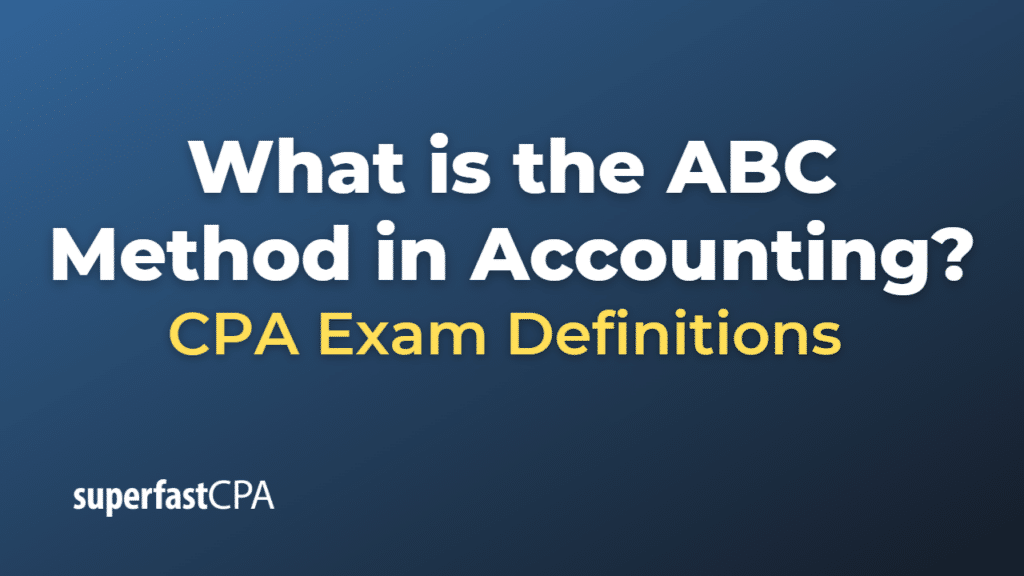ABC Method in Accounting
In accounting, the ABC method typically refers to the “Activity-Based Costing” method. Activity-Based Costing (ABC) is a cost accounting approach that assigns costs to products or services based on the activities and resources consumed in their production, rather than relying on traditional allocation methods such as direct labor hours or machine hours. The primary goal of the ABC method is to provide more accurate and relevant cost information to support decision-making and cost management.
The ABC method involves the following steps:
- Identify Activities: Determine the various activities involved in the production process or the provision of services. Examples of activities may include material handling, quality control, order processing, or customer support.
- Assign Resource Costs to Activities: Calculate the costs associated with each activity by considering the resources consumed, such as labor, materials, equipment, and overhead. These costs are called activity costs.
- Determine Activity Drivers: Identify the factors that drive the consumption of resources for each activity. These factors, known as cost drivers or activity drivers, are used to allocate activity costs to products or services. Examples of cost drivers may include the number of production runs, the number of orders processed, or the hours spent on customer support.
- Assign Activity Costs to Products or Services: Allocate the activity costs to products or services based on their consumption of the identified cost drivers. This step results in a more accurate representation of the cost of each product or service.
- Calculate the Cost per Unit: Divide the total allocated costs for each product or service by the number of units produced or services provided to determine the cost per unit.
The ABC method in accounting provides a more detailed and accurate view of the costs associated with the production of products or the provision of services. By focusing on the activities and resources consumed, the ABC method can help identify inefficient processes, target areas for cost reduction, and support pricing and product mix decisions. However, it should be noted that the ABC method can be more complex and time-consuming to implement and maintain compared to traditional costing methods.
Example of the ABC Method
Let’s consider a hypothetical example of a manufacturing company that produces two types of widgets: Widget A and Widget B. The company has identified that its traditional costing method, based on machine hours, is not providing accurate cost information for decision-making. Therefore, the company decides to implement the Activity-Based Costing (ABC) method.
The company identifies the following activities and resources involved in the production process:
- Material handling
- Machine setup
- Quality control
- Assembly
Next, the company assigns resource costs to the activities:
- Material handling: $50,000 per year
- Machine setup: $30,000 per year
- Quality control: $40,000 per year
- Assembly: $80,000 per year
The company then determines the cost drivers for each activity:
- Material handling: Number of material moves
- Machine setup: Number of setup hours
- Quality control: Number of inspections
- Assembly: Number of assembly hours
Suppose the company collects the following data for the production of Widget A and Widget B:
- Widget A: 500 material moves, 200 setup hours, 300 inspections, and 1,000 assembly hours
- Widget B: 1,000 material moves, 300 setup hours, 700 inspections, and 2,000 assembly hours
Using the cost drivers, the company allocates the activity costs to each widget:
- Material handling:
- Widget A: ($50,000 / 1,500 material moves) * 500 material moves = $16,667
- Widget B: ($50,000 / 1,500 material moves) * 1,000 material moves = $33,333
- Machine setup:
- Widget A: ($30,000 / 500 setup hours) * 200 setup hours = $12,000
- Widget B: ($30,000 / 500 setup hours) * 300 setup hours = $18,000
- Quality control:
- Widget A: ($40,000 / 1,000 inspections) * 300 inspections = $12,000
- Widget B: ($40,000 / 1,000 inspections) * 700 inspections = $28,000
- Assembly:
- Widget A: ($80,000 / 3,000 assembly hours) * 1,000 assembly hours = $26,667
- Widget B: ($80,000 / 3,000 assembly hours) * 2,000 assembly hours = $53,333
Now, the company calculates the total allocated costs and cost per unit for each widget:
- Widget A: 10,000 units produced, total cost = $16,667 + $12,000 + $12,000 + $26,667 = $67,334
- Cost per unit for Widget A: $67,334 / 10,000 units = $6.73
- Widget B: 5,000 units produced, total cost = $33,333 + $18,000 + $28,000 + $53,333 = $132,666
- Cost per unit for Widget B: $132,666 / 5,000 units = $26.53
By using the Activity-Based Costing method, the company now has a more accurate representation of the production costs for Widget A and Widget B. This information can be used to make better decisions regarding pricing, product mix, and cost reduction initiatives.













